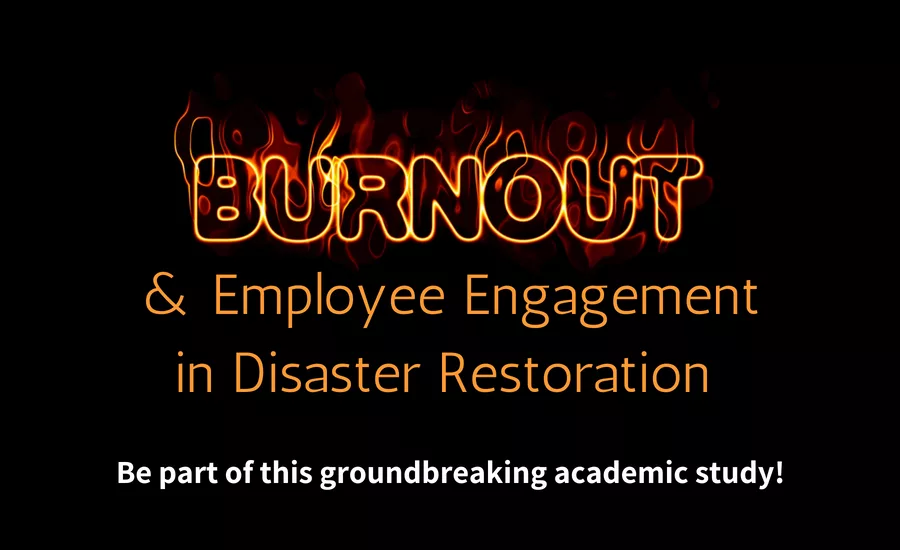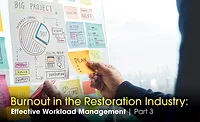Industry Study: Employee Engagement & Burnout in Disaster Restoration
College professors join forces to examine employee burnout and engagement in the disaster restoration industry.

Please help Dr. Jacob Avila of MTSU and Dr. Randy Rapp of Purdue University advance our understanding of employee burnout and engagement in the disaster restoration industry. Please click on the following link to participate. Please also distribute the link to all industry professionals who are (1) at least 18 years old and (2) currently employed by a U.S.A. or Canadian-based company in the disaster restoration industry.
Here is a link to participate in the study.
Here is a link to the formal university approved flyer.
About the Study
Dr. Jacob Avila is an associate professor of construction management at Middle Tennessee State University and Dr. Randy Rapp, P.E. is an associate professor of construction management at Purdue University. Together, they are conducting a study to examine employee burnout and engagement in the disaster restoration industry.
Your response to this anonymous survey is crucial to advancing our collective understanding of restoration work and identifying intervention strategies that may serve to enhance the health and engagement of professionals working in the disaster restoration industry.
If you are at least 18 years old and currently employed (in any capacity and at any level) by a U.S.A. or Canadian-based company in the disaster restoration industry please take this survey. The survey will take approximately 20 minutes to complete and is completely anonymous.
Participants will need an internet connection and may complete the survey using a computer or mobile device. Participants are free to stop working on the survey at any time; however, completing the entire survey is appreciated, encouraged, and will maximize the value of these research efforts.
There are four sections to the survey:
- Demographics (17 items)
- Maslach Burnout Inventory (16 items)
- Areas of Worklife Survey (28 items)
- Exit (3 items)
Surveys will be anonymous, participants may withdraw at any time, and the researchers will make no attempts to extract personal or identifying information. It is expected that participation in this study will provide participants with no more than minimal risk or discomfort, which means they should not experience participation as any more troubling than their normal daily life. However, there is always the chance that there are some unexpected risks. Foreseeable risks in this study include an accidental disclosure of participants’ private information in the last question of the survey that includes a comment box or discomfort by answering questions that are embarrassing.
Please click on the arrow below to participate in the anonymous study. By clicking on the arrow and proceeding to the survey you are (1) consenting to participate in the study, (2) affirming you are at least 18 years old, and (3) affirming you are currently employed by a U.S.A. or Canadian-based company in the disaster restoration industry.
Thank you for your willingness to make a valuable contribution to enhance the work of all professionals serving in the disaster restoration industry. Should you have any questions or concerns regarding this study please contact Dr. Jacob Avila by email at jacob.avila@mtsu.edu or phone at 615-898-5715.
Please share links to the survey with professionals in the disaster restoration industry whom you believe qualify to participate. Please complete only one survey per individual.
Purpose of the Study
The purpose of this research is to (1) apply structural equation modeling to study the factor structure and validity of the Maslach Burnout Inventory (MBI) and Areas of Worklife Survey (AWS) across occupational roles within the disaster restoration industry and (2) explore dynamics and potential trends related to burnout, workplace context, and engagement within the industry. The researchers intend to make contributions to academic theory and professional practice. The data will be analyzed and used to prepare papers for submission to academic journals and pursue opportunities to publish in the professional literature within the industry.
The following hypotheses will be tested:
- The MBI will demonstrate internal consistency estimates above .70 for each subscale.
- The AWS will demonstrate internal consistency estimates above .70 for each subscale.
- The workload domain of the AWS will be the most important antecedent for predicting burnout (MBI).
Practically speaking, the questions driving this research are:
- What are the psychological responses to the daily experiences of restoration professionals?
- What attributes of work and workplace context drive burnout for restoration professionals?
- What attributes of work and workplace context enhance engagement for restoration professionals?
Background
The disaster restoration industry is a niche within the construction industry. Professionals specializing in this type of construction work long hours and are often required to be on call to respond to emergency situations. The nature of the work can range from water damage, earthquake damage, and structure fire repair to environmental remediation, biohazard decontamination, and large scale catastrophes. To date, it seems no work has been done using any instruments, to systematically explore burnout, workplace context, and engagement within this industry. The researchers hope to build theory by further validating these instruments and advance practice by exploring current trends and potential intervention strategies that may serve to enhance the health and engagement of professionals in this line of work.
Rationale and Relevance
Scholars have made advancements over the years in developing new measures for understanding burnout (Maslach & Jackson, 1981; Pines, Aronson, & Kafry, 1981; Maslach, Leiter, & Schaufeli, 2008; Maslach, Jackson, Leiter, & Schaufeli, 2016), workplace context (Leiter & Maslach, 2011; Bakker & Demerouti, 2014), and engagement (Schaufeli & Bakker, 2004) across many industries. The contribution to theory for this study will stem from applying these tools in a sequence and to a population that has not been studied in such a manner. In addition, a contemporary academic discussion regarding burnout and engagement suggests these are two separate phenomena that need to be measured and examined individually and not two opposite ends of the same spectrum as others have contended (Schaufeli, Salanova, Gonzalez-Roma, & Bakker, 2002).
One of the primary goals of this study is to make a contribution to practice by exploring the dynamics of burnout, workplace context, and engagement within a particular subset of the construction industry. The nature of the work these professionals take on is mentally and physically challenging. Most restoration professionals find themselves working in an environment that is owner (client) occupied and post-disaster. The stress owners are consumed by after a loss is driven by many complicated factors. Sometimes owners are dealing with the loss of a loved one who may have died in the home due to an accident or unfortunate incident. Even in the absence of such loss owners often grapple with the loss of personal items or the stress associated with the inconvenience of having their home worked on or seeing their home in a damaged state. For the restoration professional, they must be sensitive to these dynamics, but also keenly aware of the importance of their role in effectively restoring physical property in a timely and cost-effective manner.
It is the hope of the researchers that this work will reveal behavioral and work related trends that can enhance worker satisfaction, health, performance, and the overall effectiveness of the restoration process for professionals working in this field and, ultimately, for the customers they serve. As a result, the researchers found it important to use validated instruments that have been tested over time and across many populations.
Study Design
The authors intend to recruit a sample of 2,000 professionals working in U.S.A. and Canadian-based companies within the restoration industry. Inclusion criteria will be as follows: (a) 18 years old and (b) currently employed by a U.S.A. or Canadian-based restoration industry company providing emergency services, water extraction, environmental remediation, specialty cleaning, contents pack out and restoration, reconstruction, or some other closely related specialty.
Participants will be recruited by announcing the study through trade organizations, company HR departments, individuals, industry media, and franchise headquarters by asking them to disseminate links to an online survey to their members, employees, colleagues, and business partners. Consent is addressed in the instructions prior to administering the survey and will read as follows:
“Please click on the arrow below to participate in the anonymous study. By clicking on the arrow and proceeding to the survey you are (1) consenting to participate in the study, (2) affirming you are at least 18 years old, and (3) affirming you are currently employed by a U.S.A. or Canadian-based company in the disaster restoration industry.”
The measures utilized in the study will include the Maslach Burnout Inventory (Maslach, Jackson, Leiter, & Schaufeli, 2016) and Areas of Worklife Survey (Leiter & Maslach, 2011). Participants will be assessed on a single occasion and participation should last approximately 15-20 minutes. Data collection is scheduled to commence August 2018 and conclude December 2018, and will be anonymous to ensure confidentiality and reduce the likelihood of response bias. No deception will occur in the study, and there will be no manipulation of variables. Data will be gathered using Qualtrics.
Surveys will be anonymous, participants may withdraw at any time, and the researchers will make no attempts to extract personal or identifying information. It is expected that participation in this study will provide participants with no more than minimal risk or discomfort, which means they should not experience participation as any more troubling than their normal daily life. However, there is always the chance that there are some unexpected risks. Foreseeable risks in this study include an accidental disclosure of participants’ private information in the last question of the survey that includes a comment box or discomfort by answering questions that are embarrassing.
Data Analysis
Once data are gathered, the authors will analyze the results with Qualtrics and SPSS. The results will be written up and submitted to a peer-reviewed construction management or business related journal for publication consideration.
Looking for a reprint of this article?
From high-res PDFs to custom plaques, order your copy today!







